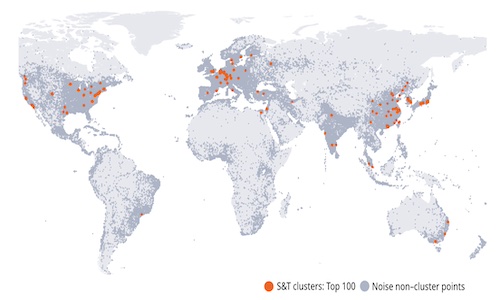As a part of the Global Innovation Index, WIPO released the Science and Technology (S&T) Cluster Ranking revealing 100 world-leading science and technology hubs. The five (5) biggest S&T clusters are all situated in East Asia, led by Tokyo-Yokohama (Japan), Shenzhen-Hong Kong-Guangzhou (China and Hong Kong, China), Beijing (China), Seoul (Republic of Korea) and Shanghai-Suzhou (China) clusters.
Image credit to WIPO Statistics Database, April 2024
Map 1 Top 100 clusters worldwide, 2024
Note: Noise refers to all inventor/author locations not classified as being within a cluster.
Global Innovation Index
https://www.wipo.int/en/web/global-innovation-index The Global Innovation Index (GII) ranks the world’s leading economies according to their innovation capabilities. It demonstrates the most innovative economies in the world, ranking the innovation performance of around 132 economies while highlighting innovation strengths and weaknesses. The Index is inclusive of approximately 80 indicators, measuring political environment, education, infrastructure and knowledge creation of each economy.
Science and Technology (S&T) Cluster Ranking of 2024
The S&T clusters were defined by the examination of patent-filing activity, scientific article publication, documenting geographic regions, countries, cities having highest density of inventors, and scientific authors. As the top performing clusters, Tokyo-Yokohama (Japan – 1st place) and Shenzhen–Hong Kong–Guangzhou (China – 2nd place) have a large output of Patent Cooperation Treaty (PCT) which are the greatest number of patents applied by Mitsubishi Electric and Huawei respectively. China and the United States have the most S&T clusters in the top 100 S&T.
Kuala Lumpur (Malaysia) ranked 93rd, made its first appearance in the top 100 S&T clusters for the first time. MIMOS (Malaysia’s National Applied Research and Development Centre) is Kuala Lumpur’s top patent applicant and active in semiconductor research, and the Universiti Malaya the top publishing organisation.
It is interesting that Samsung Electronics appears as the top patent applicant across several economies and organisations, including Seoul National University (Korea), Lomonosov Moscow State University (Russia), IISC – Bangalore (Bengaluru, India), University of Warsaw (Poland), followed by LM Ericsson patentee through Karolinska Institutet (Stockholm, Sweden), and Complutense University of Madrid (Spain).
Half of all PCT applications in the top 100 clusters fall within 7 fields of technology, including: Computer technology (12%), Digital communication (11.5%), Electrical machinery, apparatus, energy (6.6%), Medical technology (6.5%), Audio–visual technology (4.7%), Measurement (4.6%) and Pharmaceuticals (4.5%). These top 10 clusters contribute 65% to the overall total.
Sources:
Cluster ranking 2024:
Appendix IV – Global Innovation Index science and technology cluster methodology:
Press release:
https://www.wipo.int/en/web/global-innovation-index/2024/science-technology-clusters

Leave a Reply
You must be logged in to post a comment.